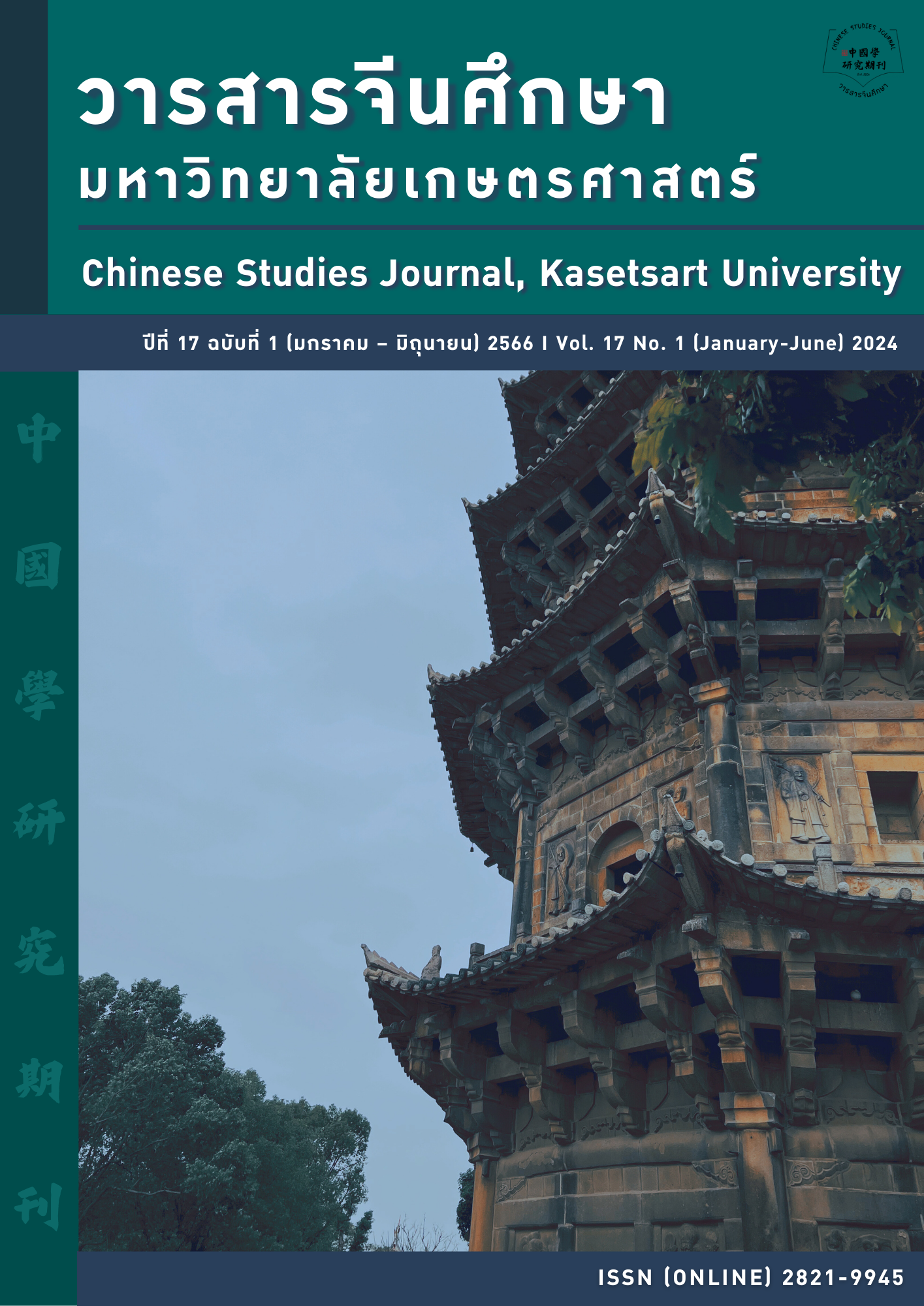Error Analysis and Acquisition Research on the Chinese Particle “了” among Thai Chinese Learners of Different Proficiency Levels การศึกษาข้อผิดพลาดและการเรียนรู้การใช้คำไม่แท้ “了” ของผู้เรียนภาษาจีนชาวไทยที่มีระดับความรู้ทางภาษาต่างกัน
Main Article Content
Abstract
In the field of teaching Chinese as a foreign language, the particle “了”has long been regarded as a major challenge for Chinese learners due to its diverse meanings and functions, as well as the high mistake rate among foreign learners. In order to improve the efficiency of teaching the Chinese particle “了” to Thai learners, this study, based on the Sun Yat-sen University corpus, randomly sampled 30 essays from Thai learners at elementary, intermediate, and advanced levels of proficiency in Chinese. Guided by theories such as the Order of Acquisition Hypothesis and Error Analysis Theory, the study analyzed the common errors in the use of specific grammatical patterns involving “了1” and “了2”among Thai learners, as well as their acquisition order and error patterns. The research found that the overall mistake rate of “了1”gradually decreased with the increase of proficiency level, while the mistake rate of "了2" showed a rebound phenomenon at the advanced level compared to the intermediate level. Additionally, learners' frequency of using “了1” and “了2”showed an overall increasing trend with the improvement of proficiency. Based on the mistake rates of each grammatical pattern, a sequence of acquisition from difficult to easy was derived: for "了1" patterns, at the elementary level: L1-3=L1-4>L1-6>L1-1>L1-5>L1-2; at the intermediate level: L1-3>L1-1>L1-4>L1-5>L1-2=L1-6; at the advanced level: L1-3>L1-6>L1-1>L1-5>L1-2=L1-4. For "了2" patterns, at the elementary level: L2-3>L2-2>L2-1; at the intermediate level: L2-1>L2-2=L2-3; at the advanced level: L2-1>L2-3>L2-2. Based on the acquisition order and mistake patterns of “了1” and “了2”patterns among Thai learners at different proficiency levels, this study suggests personalized teaching and emphasizes situational teaching in instruction.
Article Details

This work is licensed under a Creative Commons Attribution-NonCommercial-NoDerivatives 4.0 International License.
ผลงานทางวิชาการที่ลงตีพิมพ์ในวารสารจีนศึกษา มหาวิทยาลัยเกษตรศาสตร์ เป็นลิขสิทธิ์ของผู้เขียนหรือผู้แปลผลงานนั้น หากนำลงในวารสารจีนศึกษาเป็นครั้งแรก เจ้าของผลงานสามารถนำไปตีพิมพ์ซ้ำในวารสารหรือหนังสืออื่นได้โดยมิต้องแจ้งให้ทราบล่วงหน้า แต่หากผลงานที่ได้รับพิจารณานำลงในวารสารจีนศึกษา เป็นผลงานที่เคยตีพิมพ์ที่อื่นมาก่อนเจ้าของผลงานต้องจัดการเรื่องปัญหาลิขสิทธิ์กับแหล่งพิมพ์แรกเอง หากเกิดปัญหาทางกฎหมาย ถือว่าไม่อยู่ในความรับผิดชอบของวารสารจีนศึกษา มหาวิทยาลัยเกษตรศาสตร์ ทั้งนี้ ความคิดเห็นต่างๆ ในบทความเป็นความคิดเห็นส่วนตัวของผู้เขียน ไม่เกี่ยวกับกองบรรณาธิการวารสารจีนศึกษา มหาวิทยาลัยเกษตรศาสตร์
References
陈楚芬.(2005). 面向泰国汉语教学的现代汉语“了”的考察.博士学位论文,南京师范大学.
丁桂贤.(1990). 关于外国人学习汉语助词“了”的几个问题.湖南师范大学社会科学学报,02,99-103.
邓芸芸.(2013). 中高级阶段泰国学生使用“了”的偏误研究 [硕士学位论文].广西大学.
房玉清.(1992). 动态助词“了”“着”“过”的语义特征及其用法比较.汉语学习,01,14-20
黄伯荣,廖旭东.(2011). 《现代汉语》(增订六版)下册.高等教育出版社.
贺龙菲.(2015). 泰国留学生语气词“了”习得偏误研究 [硕士学位论文].暨南大学.
吕叔湘.(1980). 《现代汉语八百词》.商务印书馆.
刘月华.(1983). 《实用现代汉语语法》.外语教学与研究出版社.
刘勋宁.(2002). 现代汉语句尾“了”的语法意义及其解说.世界汉语教学,03,70-79.
刘敏 & 陈晨.(2012). 泰国留学生汉语“了”的习得考察. 海外华文教育,03,302-309.
李晓琪.(2005). 《现代汉语虚词讲义》.北京大学出版社.
鲁健骥.(1992). 偏误分析与对外汉语教学.语言文字应用,01,69-73.
孙德坤.(1993). 外国学生现代汉语“了·le”的习得过程初步分析.语言教学与研究,02,65-75.
孙德金.(1999). 《外国学生汉语体标记“了”“着”“过”习得情况考察》. 北京语言文化大学.
王美娟.(2017). 泰国留学生“了”的习得研究 [硕士学位论文].广西民族大学.
谢安安.(2015). 汉语“了”和泰语“แล้ว”的对比分析.北京大学中国语言文学系,01,171-193.
玄美兰.(2004). 日本学生汉语习得“了”字句偏误分析 [硕士学位论文].延边大学.
朱德熙.(1982). 《语法讲义》.商务印书馆.
赵立江.(1997). 留学生“了”的习得过程考察与分析.语言教学与研究,2,112-124.
Krashen, S. D. (1982). Principles and practice in second language acquisition. Oxford Pergamon Press.
Lightbown, P. M., & Spada, N. (1993). How Languages are Learned (1st ed.). Oxford University Press.
Suchachip. (2005). A COMPARATIVE STUDY OF “LE” IN MANDARIN AND “LEEW” IN THAI [Master Thesis].
Chulalongkorn University.


